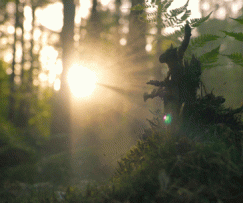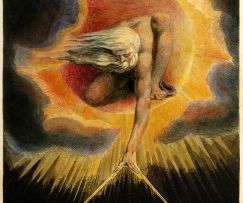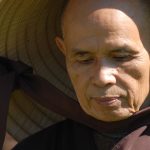First published in New Renaissance, Vol 10, no.1, 2001.
 We all experience ‘higher states of consciousness’ from time to time, when an inner peace seems to fill us and the world around us seems magically transformed. Everything seems much more real and more beautiful, we feel like we’re actually part of our surroundings, and there seems to be a meaning in things which we aren’t normally aware of. The world seems a benevolent place, with a harmony in it, and we may even become aware of a kind of force or presence which seems to pervade all things.
We all experience ‘higher states of consciousness’ from time to time, when an inner peace seems to fill us and the world around us seems magically transformed. Everything seems much more real and more beautiful, we feel like we’re actually part of our surroundings, and there seems to be a meaning in things which we aren’t normally aware of. The world seems a benevolent place, with a harmony in it, and we may even become aware of a kind of force or presence which seems to pervade all things.
We also have a sense that we’re seeing the world in a wider and truer way that normal, as if a veil has been pushed aside and we’re catching a glimpse of how things really are.
Studies have shown that, while these ‘higher states of consciousness’ can occur for no apparent reason, they are often ‘triggered’ by certain things: they often occur when we’re amongst natural surroundings, for example, or when we do meditation and yoga, or after periods of emotional turmoil and depression. They also sometimes occur after or during sex, when we do certain sports (such as long-distance running), and people who suffer from epilepsy often experience them in the moments before seizures.
 Mainstream science and psychology have never really known how to deal with these experiences. Since Freud interpreted them as a regression to the ego-less state of early childhood, psychologists have tended to treat them as undesirable pathological states. They’ve been seen as a form of schizophrenia, in which the normal ‘healthy’ ego stops functioning and loses the ability to differentiate between itself and the world ‘out there’.
Mainstream science and psychology have never really known how to deal with these experiences. Since Freud interpreted them as a regression to the ego-less state of early childhood, psychologists have tended to treat them as undesirable pathological states. They’ve been seen as a form of schizophrenia, in which the normal ‘healthy’ ego stops functioning and loses the ability to differentiate between itself and the world ‘out there’.
Recently neuroscientists have put forward explanations of them too. Noting that they often occur in times of crisis, one theory suggests that they’re caused by an ’emergency response mechanism’ in the brain. This is the part of the brain which is ‘switched on’ whenever we’re in dangerous situations, which makes us aware of the significance of the danger so that we can respond to it in the right way. However, sometimes this mechanism can be activated accidentally – in times of high emotional or physical stress, for example, so that our brain reacts as if we’re in an emergency situation and everything we see seems to be powerfully real and full of significance.
Another theory is that these ‘spiritual’ feelings might simply be the result of natural selection. Religion makes human societies more stable and cohesive, and so gives them a better chance of surviving. So perhaps ‘spirituality’ was simply a illusory sensation (created by certain brain chemicals) which was ‘selected’ by nature because it gave rise to religious beliefs and so helped to create stable and cohesive societies.
What all these theories have in common is the assumption that there’s something aberrational about higher states of consciousness, or mystical experiences. They’re pleasant but illusory feelings which are caused by a malfunctioning of the brain or the psyche. It’s taken for granted that our ordinary state of being is the ideal state for us to be in, and one which tells us the absolute truth about the world we live in. Anything that deviates from the state, and which shows a different ‘reality’ to us must, therefore, be unhealthy and illusory.
But in actual fact it makes a lot more sense if we take the exact opposite stance to this – if we say that it’s our ordinary state of consciousness which shows a false reality to us, and it’s only in higher states of consciousness that we glimpse ‘reality’. In other words, it’s our ordinary consciousness which has something ‘wrong’ with it, and only higher states of consciousness should be considered normal and healthy.
Native Peoples and Children
 The strange thing is that there are some peoples in the world who seem to naturally live in what we could call a higher state of consciousness, or at least something close to it. Peoples like the Native Americans and the Australian Aborigines seem to perceive the world around them in a much more real way than modern Europeans or Americans.
The strange thing is that there are some peoples in the world who seem to naturally live in what we could call a higher state of consciousness, or at least something close to it. Peoples like the Native Americans and the Australian Aborigines seem to perceive the world around them in a much more real way than modern Europeans or Americans.
Whereas we normally perceive natural things as ‘objects’ with no life inside them, to them all things are alive. They seem to be able to sense a spiritual essence in things, a kind of force which pervades all of reality and unites all superficially separate things into a one-ness. (This is what Indian philosophy calls Brahman, and which Native Americans sometimes call the ‘Life Master’ or the ‘Great Spirit.’) These peoples also don’t seem to experience the sharp duality between the individual and a world ‘out there’ which is our normal state. They seem to naturally experience a degree of the sense of connectedness and belonging to the world which is a facet of what we call higher states of consciousness.
It’s also strange that we seem to experience a degree of this kind of vision of the world as children. The idea that children live in a higher state of consciousness than us may seem absurd, but it’s certainly true that, as children, we experience the world in the same intensely real way which native peoples do. As children we find the world an incredibly fascinating place, we stare in awe and wonder at ‘humdrum’ things which adults no longer bother giving their attention to, and we feel a powerful natural delight in being alive. Because our ego’s haven’t yet become strongly developed, we also have a natural sense of connectedness to the world – instead of being ‘in here’ with the world ‘out there’, we are, in a sense, ‘out there’ with the world. This has been confirmed by the studies of the American psychologist H. Werner, who – in Comparative Psychology of Mental Development – notes that the perceptions of both native peoples and children are ‘more vivid and sensuous, and de-differentiated with respect to the distinctions between self and object and between objects.’
What this suggests is that, rather than being a kind of aberration, there is something natural and normal about higher states of consciousness – perhaps even that they are our original state. It’s almost as if something ‘went wrong’ in our development, which caused us to lose it.
The Ego and the ‘Familiarity Mechanism’
 As I see it, there were actually two things which ‘went wrong’. The first was the development of a strong sense of ego. The archaeologist and geographer James DeMeo has shown recently that the ancestors of modern human beings such as the Indo-Europeans and the Semites originated in an area which he calls ‘Saharasia’ – the enormous belt of arid land which stretches from North Africa, through the middle East, and into central Asia. 6,000 years ago and before, however, the area wasn’t arid at all, but was a fertile grassland, full of human and animal life. But at around 4000 BCE, beginning in the Near East and Central Asia, it started to dry up. Rainfall decreased, rivers and lakes evaporated, vegetation disappeared and famine and drought took hold. This created massive social devastation, and also seems to have caused a kind of ‘psychic transformation’ amongst the peoples who inhabited the area. Whereas before they had been peaceful and egalitarian, now they became extremely war-like and oppressive. According to DeMeo’s research, this is the historical point where war, male domination, caste or class systems and a negative attitude to sex and the human body become common.
As I see it, there were actually two things which ‘went wrong’. The first was the development of a strong sense of ego. The archaeologist and geographer James DeMeo has shown recently that the ancestors of modern human beings such as the Indo-Europeans and the Semites originated in an area which he calls ‘Saharasia’ – the enormous belt of arid land which stretches from North Africa, through the middle East, and into central Asia. 6,000 years ago and before, however, the area wasn’t arid at all, but was a fertile grassland, full of human and animal life. But at around 4000 BCE, beginning in the Near East and Central Asia, it started to dry up. Rainfall decreased, rivers and lakes evaporated, vegetation disappeared and famine and drought took hold. This created massive social devastation, and also seems to have caused a kind of ‘psychic transformation’ amongst the peoples who inhabited the area. Whereas before they had been peaceful and egalitarian, now they became extremely war-like and oppressive. According to DeMeo’s research, this is the historical point where war, male domination, caste or class systems and a negative attitude to sex and the human body become common.
Our ancestors seemed to have developed their strong and sharp sense of individuality in response to this environmental disaster. The hardship which filled their lives as their environment began to change – as their crops began to fail, as the animals they hunted began to die, as their water supplies began to fail and so on – must have encouraged a spirit of selfishness. In order to survive, people had to start thinking in terms of their own needs rather than those of the whole community, and to put the former before the latter. In addition, the new difficulties they faced must have brought a need for a new kind of intelligence, a practical and inventive problem-solving capacity. They were forced to think more, to develop new powers of self-reflection, to begin to reason and ‘talk’ to themselves inside their heads. And they could only do this by developing a stronger sense of ‘I’. After all, self-reflection is the ‘I’ inside our heads talking away to itself. If you want to be inventive or to deliberate or plan ahead, you have to have an ‘I’ to think with. And these two factors may well have been responsible for our strong sense of ego.
The second thing which I believe ‘went wrong’ is connected to this. There seems to be a mechanism in our minds which ‘edits out’ the real-ness of things once we’ve been exposed to them for a while. For instance, when we go into a room with a terrible smell in it we feel nauseous and are amazed that the other people can stand it – but after a few minutes we seem to ‘switch off’ to the intensity of the smell and it no longer affects us as much. The same thing happens on a larger scale when we go to a foreign country for the first time, or when we move house into a new area – everything around us seems to be much more real and to clamour for our attention. We can really sense the new atmosphere and the exciting new sights and sounds. But this intensity of perception only lasts for a short time: after a few weeks (or perhaps a few months at the most) we get used to the new environment, it becomes familiar and even dreary to us – as, again, something inside us seems to ‘switch off’ to its reality.
This ‘familiarity mechanism’ – as we could call it – affects our perceptions of everything. We spend almost all our time surrounded by things which we’ve seen or experienced thousands of times before and whose reality we have, therefore, been de-sensitized to. In other words, we look at everything in the world through a veil of familiarity. In fact this is the main difference between us and children : children haven’t developed this ‘familiarity mechanism’ yet, the reality of the phenomenal world hasn’t been ‘edited out’ to them, which is why they perceive the world in such a real way, and why it’s such a fascinating place to them.
Our ancestors probably also developed this mechanism in response to the ‘Saharasian’ environmental disaster. It may partly have been a kind of ‘concentration aid’. It ‘turned off’ their attention to their surroundings so that they could focus their attention more on their survival problems, helped them to ‘narrow down’ the field of their attention to particular things, so that they could become more practical and technically skilled.
Once this mechanism developed it must have aided the development of the ego too. As the reality of the ‘outside’ world was switched off to our senses, our attention became focused inside ourselves, so that we developed a more pronounced inner life and a greater sense of duality between our selves and the world.
Ordinary Consciousness
 These are the two main factors which have gone into the development of our normal consciousness. The ‘familiarity mechanism’ means that the world is a fairly dreary place to us – and also an inanimate place, so that we see stones, rivers and even the earth itself as inert chemical machines, and so that we aren’t aware of the spiritual essence which flows through all things and makes them one. And our strong sense of ego means that we experience a strong sense of disconnection to the world, and live inside ourselves instead of actually in the world.
These are the two main factors which have gone into the development of our normal consciousness. The ‘familiarity mechanism’ means that the world is a fairly dreary place to us – and also an inanimate place, so that we see stones, rivers and even the earth itself as inert chemical machines, and so that we aren’t aware of the spiritual essence which flows through all things and makes them one. And our strong sense of ego means that we experience a strong sense of disconnection to the world, and live inside ourselves instead of actually in the world.
But it’s hopefully clear by now that the assumption that this normal consciousness is perfectly healthy and gives us a ‘true’ vision of the world is completely wrong. This consciousness is the result of a ‘fall away’ from the more intense and fuller consciousness of native peoples and children, the end result of a process of limiting and filtering our awareness of reality, so that what we’re left with is a vision of the world which, far from being ‘correct’, is actually only a kind of false shadow reality.
In other words, our normal consciousness is really a kind of ‘sleep’, which we’re so used to that we don’t even realise we’re in it. And the importance of higher states of consciousness is that when we have them we ‘wake up’. When we meditate, when we’re alone in nature or when we go long-distance running (or any occasion when we experience higher states of consciousness) we often manage to free ourselves from these limiting mechanisms. I haven’t got space here to explain how this happens in detail (I try to do this in my yet-to-be-published book, Waking Up From Sleep), but it’s mainly because, in these moments, the channels through which we normally give away our vitality (or life-energy) close down. We normally give our vitality away by being active, by thinking, and through the work we have to do to process the sensory material which around us. But when we meditate, for example, we’re completely inactive, our senses are closed to the external world and our minds are (hopefully) no longer filled with thought-chatter; as a result we retain our viality. And this means that, since the essential purpose of the ‘famliarity mechanism’ is to save attentional energy, there’s no need for it to function, in the same way that you no longer need to save money when there’s a lot of it in your bank account. So for once our perceptions become free of the famliarity mechanism, and able to perceive the incredibly beautiful, animate and harmonious world which is normally hidden from us.
What this means is that we shouldn’t treat higher states of consciousness as illusions – instead we should see them as temporary glimpses of reality. And it’s also important to remember that these glimpses don’t have to remain just temporary. After all, this is what spiritual practice is all about: turning the ‘peak experience’ into the ‘plateau experience’, turning these temporary ‘waking up experiences’ into a permanent state of wakefulness. Spiritual development is (from this point of view at least) a process of gradually ‘undoing’ the development of the ego and of the familiarity mechanism, which eventually leads to a permanent higher state of consciousness. Every time we sit down to meditate, every time we do yoga, or when we manage to detach ourselves a little more from external sources of happiness or to make our lives less active or less hedonistic, we take a step closer to reality.












